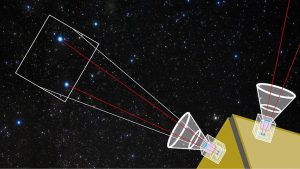Understanding how accurate a satellite star tracker is provides valuable insights into the technology’s role in space navigation. Star trackers are critical for determining the precise orientation of satellites and spacecraft, ensuring their successful operation and mission outcomes. This article explores the accuracy of satellite star trackers, the factors influencing their precision, and the technological advancements enhancing their performance.

The Role of Star Trackers in Space Missions
Satellite star trackers are essential instruments used to determine the attitude of a spacecraft. By capturing images of stars and comparing them to an onboard star catalog, these devices can precisely calculate the spacecraft’s orientation. The accuracy of a satellite star tracker is crucial for various mission tasks, including navigation, communication, and scientific data collection.
Factors Influencing Star Tracker Accuracy
Several factors contribute to the accuracy of satellite star trackers. The primary determinants include:
- Optical System Quality: The quality of the star tracker’s optical system, including lenses and mirrors, directly affects its ability to capture clear and detailed images of the star field.
- Sensor Resolution: High-resolution sensors enable the star tracker to detect and differentiate between closely spaced stars, improving measurement precision.
- Star Catalog Accuracy: The onboard star catalog must be accurate and up-to-date, containing precise positions and magnitudes of stars for reliable comparison.
- Processing Algorithms: Advanced algorithms are used to process the captured star images, identify stars, and match them with the catalog. Efficient and accurate algorithms enhance the overall accuracy of the star tracker.
Measuring Star Tracker Accuracy
The accuracy of a satellite star tracker is typically measured in terms of angular precision, expressed in arcseconds or arcminutes. Modern star trackers achieve remarkable accuracy, often within a few arcseconds. This level of precision allows spacecraft to maintain a stable and correct orientation, which is essential for high-resolution imaging, scientific measurements, and reliable communication.
Technological Advancements Enhancing Accuracy
Advancements in technology have significantly improved the accuracy of satellite star trackers. Innovations include:
- Enhanced Sensors: The development of advanced CCD (Charge-Coupled Device) and CMOS (Complementary Metal-Oxide-Semiconductor) sensors with higher resolution and sensitivity allows star trackers to capture more detailed images with less noise.
- Robust Algorithms: Improved algorithms for star identification and attitude determination reduce errors and enhance the accuracy of the measurements.
- Radiation-Hardened Components: Space environments expose star trackers to high levels of radiation. Using radiation-hardened components ensures long-term reliability and accuracy.
- Artificial Intelligence: AI and machine learning algorithms are being integrated into star trackers to improve their ability to adapt to changing conditions and correct errors autonomously.
Applications Requiring High Accuracy
High accuracy in satellite star trackers is essential for various applications:
- Earth Observation: Satellites used for Earth observation need precise orientation to capture high-resolution images for environmental monitoring, disaster response, and resource management.
- Astronomical Observations: Scientific missions studying celestial objects require accurate pointing of telescopes and instruments to collect valuable data.
- Navigation and Communication: Communication satellites must maintain a stable orientation towards Earth to ensure uninterrupted data transmission.
Challenges and Future Trends
While modern star trackers are highly accurate, they still face challenges such as:
- Space Debris: The presence of space debris can obstruct the view of stars, affecting the accuracy of star trackers.
- Thermal Variations: Temperature changes in space can impact the performance of optical components and sensors, necessitating robust thermal management solutions.
Future trends in star tracker technology aim to address these challenges and further enhance accuracy. Research is ongoing in the development of more resilient materials, improved thermal management systems, and advanced AI-driven algorithms.
In conclusion, the accuracy of satellite star trackers is a cornerstone of successful space missions. With advancements in sensor technology, processing algorithms, and AI integration, modern star trackers achieve exceptional precision. As technology continues to evolve, star trackers will become even more accurate, reliable, and integral to the exploration and utilization of space.
![]()